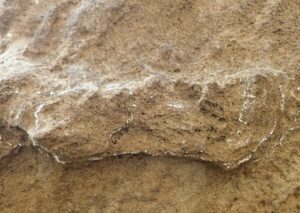
Stretching from the border with Namibia to the border of Mozambique, the coastline of South Africa extends an impressive 1,770 miles. In many places, its dramatic scenic allure reminds one of the rugged, rocky coastline of northern California, drawing both local and foreign visitors throughout the year as they escape to popular resort destinations. Perhaps less known to the general public, however, are coastal locations that in recent years have yielded tantalizing clues to a modern human presence dating back as much, or even more than, 100,000 years. Here, scientists have uncovered evidence for behaviorally modern humans who lived in caves such as Blombos and Pinnacle Point, who crafted comparatively advanced stone and bone tools, created symbolic art, and exploited marine environments, requiring a level of cooperation, organization and planning unrecorded for their earlier hominin ancestors. To some scientists, these discoveries suggest the birthplace of the first behaviorally modern humans — surviving and thriving in a resource-rich southern coastal refugium during a time when other locations were not as hospitable.
Ancient Tracks
Along with ancient caves, the South African coast also features another geological formation known as aeolianite — coastal limestone consisting of carbonate sediment that has formed into coastal dunes by the wind, and then lithified (hardened into stone) with the passage of time. These geologic structures take tens of thousands of years to form, today characterizing part of the greater Pleistocene deposits that make up what is called the Bredasdorp Group, marine and marine-related formations along the coast of South Africa’s Cape Province. Within these aeolianites lie a physical record of life, like the tracks of animals that once lived and traveled along the dunes long before they solidified into their present state. It turns out these animal tracks also included those of humans, discovered first in 1964 at the site of Nahoon in South Africa’s Eastern Cape Province. Found in hyporelief (natural casts of solidified impressions on the original surface) they were dated by optically stimulated luminescence (OSL) to about 124,000 years ago. More tracks identified as human, this time in epirelief (the solidified impressions in the original surface), were also discovered at Langebaan in the Western Cape Province in 1995 and dated to about 117,000 years ago. And in 2016 at Brenton-on-Sea, a series of 40 tracks in hyporelief were discovered on the ceiling and walls of a coastal cave, with an estimated date of about 90,000 years ago. A more precise date for this latter site awaits the results of OSL analysis. Without doubt, these aeolianite tracks have added a new dimension to the mounting evidence for early modern humans on the South African coastal landscape.
But new developments have expanded on this story……..
New Sites
Most recently, a team of scientists led by Charles Helm of Nelson Mandela University in Port Elizabeth, South Africa, along with experts from the University of Colorado, Denver and the Council for Geoscience in Cape Town, South Africa, identified a number of additional human footprints at new coastal sites. The discoveries were actually made within the context of a larger endeavor, where the researchers documented more than 250 animal track sites across 350 kilometers, even identifying animals not previously represented in the fossil record for the area, such as giraffe, crocodiles, and sea turtles. But the most exciting track sites for enthusiasts and scholars of human prehistory were those exhibiting the human tracks.
Finding them was not easy. “Firstly, there were physical challenges, involving working in confined spaces in small caves, working on tracks on ceilings, or on high overhangs,” said Helm. “Secondly, in many cases the features that identified the tracks as hominin in origin were rather subtle, as dune sand does not always lead to great track quality. Photogrammetry proved really important. But perhaps the most important factor in our favor was obtaining Dr Martin Lockley as part of our team. He is an internationally renowned ichnologist, based in Colorado, and one of the global leaders in the interpretation of hominin tracks.”
Their resulting study report*, published September 29, 2020 in the South African Journal of Science, documented field investigations at four sites, three of which yielded data robust enough to draw some conclusions. The first set of tracks was identified as 18 natural casts on the ceiling of a sandy cave within the coastal area of Garden Route National Park. Only 10 of the 18 tracks were sufficiently well enough defined to be described in detail. The second set, found on the coast of the Goukamma Nature Reserve, featured no less than 32 tracks. Remarkably, these tracks were manifested in two corresponding exposed surfaces, one above on a cliff face overhang with tracks in natural cast hyporelief, and one below on a fallen block featuring the same tracks, in this case exhibited in epirelief. The third site, also along the coast of the Goukamma Nature Reserve, featured some partial track impressions. This site, however, showed what the researchers cautiously interpret as possible “ammoglyphs”, or associated markings or impressions in the ancient sand that may have been deliberately made by humans, providing a possible whisper of insight into their behavior at the location. More specifically, the team observed and recorded parallel grooves next to the track impressions, as well as “a number of smaller circular impressions, all clustered around an impression of what resembled the anterior portion of a left human foot”.* In all three sites, tracks of various sizes were identified and recorded, suggesting that there was more than one track maker at each location. The varying sizes and their positioning on the ancient surface further suggested that they consisted of a mixture of adults and juveniles, particularly as the size and shape of the larger tracks all showed a common consistency. This raises the possibility of family groups, according to the report authors, providing some possible insight into the social relationships and group structure of these early modern humans. Finally, the team returned to a previously explored site known as Brenton-on-Sea, where earlier investigations yielded as many as 40 tracks in hyporelief and cross sections on the walls and ceiling of a coastal cave, the tracks securely dated with OSL to about 117 ka. In this area, along a coastal cliff exposure, seven apparent human tracks were newly identified. The description and interpretation of this track site location remains inconclusive, however, and a more detailed study has been left for future excavation or exploration.
_______________________________
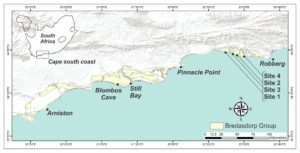
Map of South Africa and the Cape south coast, showing places mentioned and the locations of Site 1 — Site 4, and the extent of outcrops of the Bredasdorp Group. Text and image courtesy Helm, et al., Newly identified hominin trackways from the Cape south coast of South Africa, South African Journal of Science 2020.
_______________________________
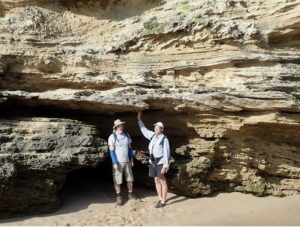
At the entrance to the small cave that contains Site 1. Image courtesy Helm, et al., Newly identified hominin trackways from the Cape south coast of South Africa, South African Journal of Science 2020.
_______________________________
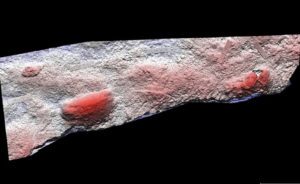
Photogrammetry color mesh of two tracks at Site 1, using 131 images. Image courtesy Helm, et al., Newly identified hominin trackways from the Cape south coast of South Africa, South African Journal of Science 2020.
_______________________________
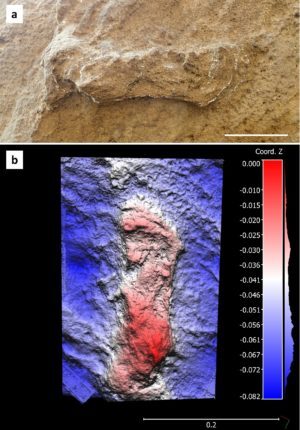
Photo image of a track, lightly outlined in chalk, at Site 1. Below the photo image, the same track in photogrammetry color mesh, using 59 images. Image courtesy Helm, et al., Newly identified hominin trackways from the Cape south coast of South Africa, South African Journal of Science 2020.
_______________________________
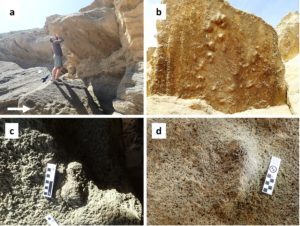
(a) The figure is standing on top of the loose slab block containing the tracks in epirelief (indicated by arrow) at Site 2. He is analyzing the tracks on the opposing/corresponding hyporelief surface above him. (b) The hyporelief surface, viewed from a distance. (c) Close-up view of a track that is only seen on the epirelief surface. (d) Close-up view of a track. Text and image courtesy Helm, et al., Newly identified hominin trackways from the Cape south coast of South Africa, South African Journal of Science 2020.
_______________________________
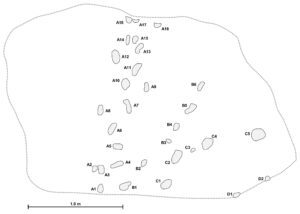
Trackway map of Site 2. Text and image courtesy Helm, et al., Newly identified hominin trackways from the Cape south coast of South Africa, South African Journal of Science 2020.
_______________________________
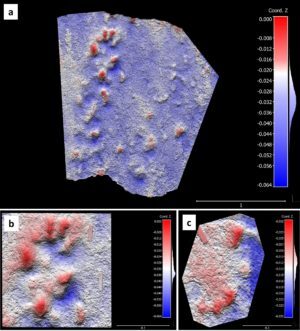
(a) Photogrammetry color mesh of the Site 2 hyporeleif surface, using 193 images. (b) Close-up photogrammetry view of tracks A9 – A15. (c) Close-up photogrammetry view of tracks B5 and B6, indicating a likely left-right sequence. Text and image courtesy Helm, et al., Newly identified hominin trackways from the Cape south coast of South Africa, South African Journal of Science 2020.
_______________________________
An Unfolding Story
Even with the publication of the report, Helm makes clear that the jury is still out on precise dating—an essential factor in interpreting the results of their research—while they await the results of testing. “Samples [from the sites described in this latest report] have been sent to the University of Leicester in the U.K., and are under the supervision of Dr Andrew Carr,” he explained. “We are reasonably confident of the approximate dates, because of other dated samples from nearby, but knowing the dates with more precision will be really important.” The sites rest in or very near to the Wilderness Embayment, where specific OSL dating of sediments have already been obtained from previous investigations. OSL results from this region yielded dates between about 148 ka to about 79 ka. Combined with the track site results from the three previous investigations at Nahoon, Langebaan, and Brenton-on-Sea, this would make South Africa arguably the region where scientists have thus far found the earliest record of Homo sapiens footprints in Africa, and possibly the world (with the possible exception of the recent Homo sapiens footprint discoveries in the Nefud Desert of Saudi Arabia).
Interpreting actual ancient human behavior at these sites, says Helm, is a somewhat trickier proposition. Referring to the finds at the third site, located in the Gaukamma Nature Reserve, Helm explains: “We have been very careful not to over-interpret in areas where we really cannot be sure. Our focus is ichnology, which includes pattern recognition. The presence of what appear to be foot impressions beside these patterns seems compelling, but we try to avoid ascribing meaning. Foraging and messaging are two possibilities, but are by no means certain. The sub-parallel grooves and the smaller [circular] depressions could have been made by a finger or a stick in the sand, but while these may be the likeliest explanations, this is speculative.”
__________________________________
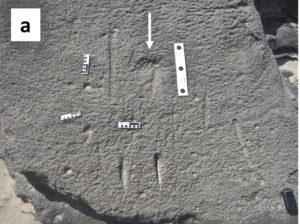
Above, the originally documented surface of Site 3, with a foot impression (indicated by arrow) and the surrounding groove and circular impression features. Below, the same site surface after scouring by wave action; white arrows indicate three likely partial human tracks; black arrows indicate newly exposed groove features after wave action. Text and image courtesy Helm, et al., Newly identified hominin trackways from the Cape south coast of South Africa, South African Journal of Science 2020.
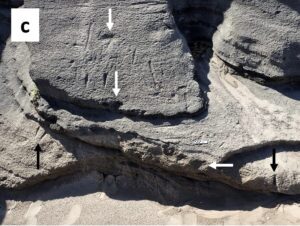
__________________________________
Going forward, Helm says that further field work and study will need to be done before the bigger picture of what was happening in this region can be formulated. Site 4 (the Brenton-on Sea site) “has potential as a possible hominin track site, but nothing more conclusive can be stated until further features are exposed, through either an excavation or natural forces or erosions.”* Indeed, the study authors maintain, all four sites are open to further excavation. But there are upsides and downsides to excavating, says Helm, including the risks involved in digging in and around cave ceilings and rock overhangs.
“No field season for me on the Cape south coast this year due to COVID,”, wrote Helm to Popular Archaeology when asked about the immediate future of research and exploration at the sites and any other new sites. “But our experience has taught us that we have to be nimble and have to keep looking. Many of the sites are ephemeral, and others are only free from sand cover for brief intervals. So, constant exploration by our team members is crucial.”
_______________________________
*Helm, C.W., Lockley, M.G., Cawthra, H.C., De Vynck, J.C., Dixon, M.G., Helm, C.J.Z, Thesen, G.H.H. Newly Identified hominin trackways from the Cape south coast of South Africa. S Afr J Sci 2020; 116(9/10), Art. #8156, 13 pages. https://doi.org/10.17.159/ says.2020/8156
More Reading:
See much more about the fascinating evidence uncovered for the earliest behaviorally modern humans in the (now free) premium article, Where Hominins Became Human, published in the Fall 2016 issue of Popular Archaeology Magazine, and the recently re-published interview of world-renowned pioneering archaeologist Christ Henshilwood in Exploring the Roots of Modern Human Behavior.
See more about how other ancient hominin track record discoveries have shed light on our understanding of human origins and human evolution in the premium articles, Laetoli: The Unfolding Story and Footprints in the Silt, both published previously in Popular Archaeology Magazine.
_______________________________
Advertisement


